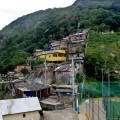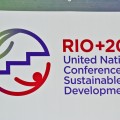Bigger or Smaller, What’s Better?
Sam Bowstead | June 21, 2012.
Every second day seems to be in recognition of something or the beginning of another conference. What makes Rio+20, the UN Conference on Sustainable Development any different?
The UN regularly organises meetings across the globe however, their ability to bring concrete change on the ground is questionable. From governments playing politics to institutional barriers, the effectiveness of these processes is contentious.
The development of an institutional framework for sustainable development is a central discussion this week, but is it fundamentally flawed in comparison to grassroots approaches?
The UN’s Copenhagen climate change conference was unable to deliver a successor to the Kyoto Protocol. Yet, recent natural disasters, particularly the earthquakes in Christchurch, New Zealand have exemplified the power of localised projects. A much publicised effort included Sam Johnson’s student volunteer army; a group of unskilled students with shovels and wheelbarrows assisting the recovery effort. Combined with a growing social media presence, this army grew to over 9,000 volunteers across the country and were recognised as local heroes.
The group wasn’t always warmly received though according to Johnson where “the Civil Defense [Department] tried to either shut down or take over the operation because of the risks of students going into a disaster zone”.
Reconstruye, a reconstruction organisation founded by Chilean architecture students following the devastating 2010 earthquake provides another example of the positive impact of grassroots activism. Founder Nicolas Valenzuela said that “we were often the first aid group people saw, which meant we had to confront the situation sensitively”. They later developed a set of ethical guidelines on how to approach disaster reconstruction in Chile.
The dynamic nature of these grassroots groups with relatively unskilled workers clearly has a place in disaster efforts. Despite the success of these efforts, their autonomy makes it hard to scale their efforts on an institutional framework level.
But that’s exactly what the UN is aiming to do. Today UNISDR held meetings to develop a framework for the 2015 International Strategy for Disaster Reduction, for which the institution is named. The idea of upscaling permeated strongly through the discussions, as experts recognised the value of local action. From farmers to architects, these grassroots examples are being highlighted as in a way that only an international conference can.
International institutions are starting to recognise the need for an alternative approach to traditional top-down interventions. “Local governments often complain about the lack of communication and access to knowledge, rather than just lack of resources,” UNISDR secretary Margareta Wahström stated.
This is where the UNISDR comes in. There is an opportunity to facilitate what’s happening on the ground, rather than creating it. By providing communities with access to knowledge and commutations at the regional and global level, resilience can be developed through education from the ground up.
Wahlström earlier stated “in the future governments are going to be less capable to deal with disaster, it will inevitably be up to the individual to be responsible for their resilience.”
UNISDR should build upon what already works on the ground, rather than creating another hierarchy to replicate it.
By Sam Bowstead, photo by Helio Coelho.












comment